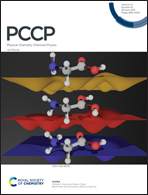Design of robust 2,2′-bipyridine ligand linkers for the stable immobilization of molecular catalysts on silicon(111) surfaces†
Abstract
The attachment of the 2,2′-bipyridine (bpy) moieties to the surface of planar silicon(111) (photo)electrodes was investigated using ab initio simulations performed on a new cluster model for methyl-terminated silicon. Density functional theory (B3LYP) with implicit solvation techniques indicated that adventitious chlorine atoms, when present in the organic linker backbone, led to instability at very negative potentials of the surface-modified electrode. In prior experimental work, chlorine atoms were present as a trace surface impurity due to required surface processing chemistry, and thus could plausibly result in the observed surface instability of the linker. Free energy calculations for the Cl-atom release process with model silyl-linker constructs revealed a modest barrier (14.9 kcal mol−1) that decreased as the electrode potential became more negative. A small library of new bpy-derived structures has additionally been explored computationally to identify strategies that could minimize chlorine-induced linker instability. Structures with fluorine substituents are predicted to be more stable than their chlorine analogues, whereas fully non-halogenated structures are predicted to exhibit the highest stability. The behavior of a hydrogen-evolving molecular catalyst Cp*Rh(bpy) (Cp* = pentamethylcyclopentadienyl) immobilized on a silicon(111) cluster was explored theoretically to evaluate differences between the homogeneous and surface-attached behavior of this species in a tautomerization reaction observed under reductive conditions for catalytic H2 evolution. The calculated free energy difference between the tautomers is small, hence the results suggest that use of reductively stable linkers can enable robust attachment of catalysts while maintaining chemical behavior on the electrode similar to that exhibited in homogeneous solution.



 Please wait while we load your content...
Please wait while we load your content...